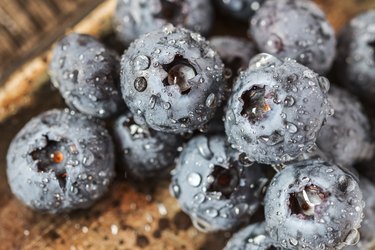
Fresh, ripe blueberries can be transformed into a complex-tasting, indigo-tinted wine. Although blueberries are available throughout the year, they are at their peak in July. For the best results in making wine, WineMaker magazine advises that you choose berries that are firm, and deep blue in color, with a translucent silver coating.
The First Steps
Video of the Day
To create a dry, fruity wine, you will need a ratio of 2 parts berries to 1 part sugar. For approximately 1 gallon of wine, use 3 pounds of berries to 1 1/2 pounds of sugar.
Video of the Day
Put the clean, fresh blueberries into a food-grade nylon mesh bag, and place the bag into a clean, 2-gallon plastic food-grade bucket; this bucket is referred to as the primary. Pour in the sugar. Add 10 cups of boiling water.
Stir the mixture, making sure to dissolve the sugar and slightly mash the berries to release their juices. Cover the bucket with a clean cloth and let it sit overnight.
Turning Fruit into Wine
To aid in the fermenting process, and to round out the flavors in the wine, you will need to add a few ingredients.
- Red wine yeast will be responsible for fermentation.
- Orange juice is mixed with the yeast to start the growth process and to add flavor to the wine.
- Campden tablets act as a sanitizer and will keep bacteria at bay.
- Pectin enzyme will clarify the wine and keep the berries from coagulating.
- An acid blend -- which is a combination of the three most common acids found in fruit: citric, malic and tartaric -- brings out the flavors of the berries and will give your wine a bit of tartness.
- Adding red grape juice concentrate will enhance the berry taste and create a deeper, more complex wine.
- Freshly grated lemon zest will brighten the berry flavor, complement the orange juice and bring in additional citrus notes.
The Method
Once the mixture, also called must, has sat overnight, mix the package of yeast with 1 cup of orange juice. Allow the yeast to sit for an hour until the mixture is foamy.
Add a crushed Campden tablet, 1 teaspoon of pectin enzyme, a ½ teaspoon of the acid blend, 1 cup of the grape juice concentrate and a ½ teaspoon of lemon zest. Combine the ingredients well.
Stir the yeast mixture into the must, and blend well. Cover the bucket with a cloth, and place it in a slightly warm, dark place to rest for 7 days.
Check on the bucket once a day, stirring the liquid to blend the ingredients.
Not Before Its Time
After a week, pull the nylon mesh bag out of the bucket. Using a very fine mesh sieve, strain the liquid into a clean glass gallon-size jar. Make certain, when pouring, that any sediment is left behind in the bucket.
Add additional water if necessary to top off the gallon.
Cap off the jar with an air-lock cap, that will keep air out of the container and ensure that your wine does not spoil. Let the jar rest for 60 days before bottling.
After 2 months, the wine is ready to be poured into clean, well-sanitized wine bottles. Age the bottles for at least 3 — and up to 6 — months before drinking.